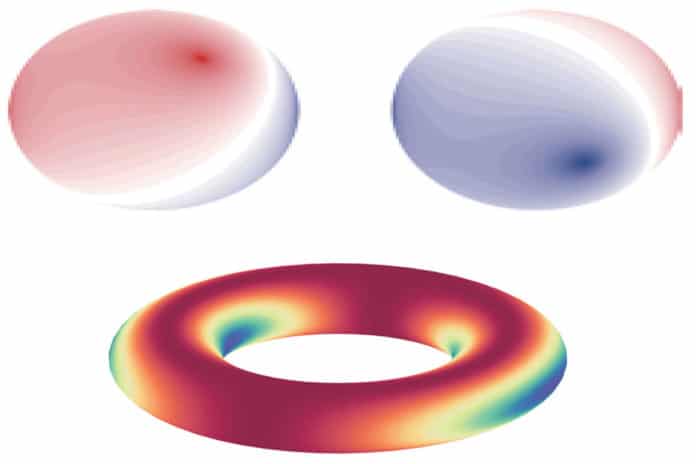The development of gauge fields is fundamental to our theoretical understanding of interactions in physical systems. There are two kinds of areas: Abelian, in which the measured effects on an observable parameter are commutative; and non-Abelian (noncommutative), where the sequence in which the field is applied matters.
In a new study, scientists for the first time, have observed an exotic physical phenomenon, involving optical waves, synthetic magnetic fields, and time reversal, following decades of attempts. This new finding that related to gauge fields could lead to realizations of what is known as topological phases, and eventually to advances toward fault-tolerant quantum computers.
Aharonov-Bohm effect is a quantum phenomenon in which a particle gets affected by electromagnetic fields even when traveling through a region of space in which both electric and magnetic field is zero. Named after the theorists who predicted it in 1959, the Aharonov-Bohm Effect confirmed that gauge fields — beyond being a pure mathematical aid — have physical consequences.
However, the observations only worked in Abelian systems. The particles take place the same way both forward and backward in time. Later on, in 1975, Tai-Tsun Wu and Chen-Ning Yang generalized the effect to the non-Abelian regime as a thought experiment.
By and by, it stayed misty whether it would even be conceivable ever to observe the effect in a non-Abelian framework. Physicists needed methods for creating the effect in the lab and furthermore methods required for recognizing the impact regardless of whether it could be produced.
Now, MIT scientists have solved both of these puzzles.
Scientists explained in their press release, “The effect has to do with one of the strange and counterintuitive aspects of modern physics, the fact that virtually all fundamental physical phenomena are time-invariant. That means that the details of the way particles and forces interact can run either forward or backward in time, and a movie of how the events unfold can be run in either direction, so there’s no way to tell which is the original version. But a few exotic phenomena violate this time symmetry.”
MIT professor of physics Marin Soljačić said, “Creating the Abelian version of the Aharonov-Bohm effects requires breaking the time-reversal symmetry, a challenging task in itself. But to achieve the non-Abelian version of the effect requires breaking this time-reversal multiple times, and in different ways, making it an even greater challenge.”
Scientists produced the effect in the lab using photon polarization. They produced two different kinds of time-reversal breaking. Later, by using fiber optics, scientists were able to provide two types of gauge fields that affected the geometric phases of the optical waves, first by sending them through a crystal biased by powerful magnetic fields, and second by modulating them with time-varying electrical signals, both of which break the time-reversal symmetry.
Making this generated interference patterns that uncovered the distinctions in how the light was affected when sent through the fiber-optic system in opposite ways, clockwise or counterclockwise. Without the breaking of time-reversal invariance, the beams ought to have been identical; however, instead, their interference patterns uncovered differences as anticipated, showing the details of the elusive impact.
MIT graduate student Yi Yang said, “The original, Abelian version of the Aharonov-Bohm effect “has been observed with a series of experimental efforts, but the non-Abelian effect has not been observed until now. The finding allows us to do many things opening the door to a wide variety of potential experiments, including classical and quantum physical regimes, to explore variations of the effect.”
Soljačić said, “The experimental approach devised by this team “might inspire the realization of exotic topological phases in quantum simulations using photons, polaritons, quantum gases, and superconducting qubits. For photonics itself, this could be useful in a variety of optoelectronic applications. Also, the non-Abelian gauge fields that the group was able to synthesize produced a non-Abelian Berry phase, and combined with interactions, it may potentially one day serve as a platform for fault-tolerant topological quantum computation.”
“At this point, the experiment is primarily of interest for fundamental physics research, to gain a better understanding of some basic underpinnings of modern physical theory. The many possible practical applications will require additional breakthroughs going forward.”
“For one thing, for quantum computation, the experiment would need to be scaled up from one single device to likely a whole lattice of them. And instead of the beams of laser light used in their experiment, it would require working with a source of single individual photons. But even in its present form, the system could be used to explore questions in topological physics, which is a very active area of current research.”
Ashvin Vishwanath, a professor of physics at Harvard University, who was not associated with this work said, “The non-Abelian Berry phase is a theoretical gem that is the doorway to understanding many intriguing ideas in contemporary physics. I am glad to see it getting the experimental attention it deserves in the current work, which reports a well-controlled and characterized realization. I expect this work to stimulate progress both directly as a building block for more complex architectures, and also indirectly in inspiring other realizations.”
The finding is reported today in the journal Science.
Other co-author of the study includes MIT visiting scholar Chao Peng (a professor at Peking University), MIT graduate student Di Zhu, Professor Hrvoje Buljan at University of Zagreb in Croatia, Francis Wright Davis Professor of Physics John Joannopoulos at MIT, Professor Bo Zhen at the University of Pennsylvania, and MIT professor of physics Marin Soljačić.
